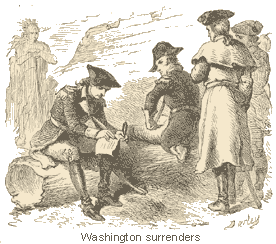The early colonial wars between France and Britain were fought primarily in Europe. American events played relatively minor roles. After three rounds, no clear victor had emerged.
Following the third of these conflicts, King George’s War (1740-1748), French authorities in North America began to establish a string of forts in the Ohio country west of the Allegheny Mountains. Their intent was to keep fur trapping and trading activities in the hands of French citizens and to deny the area to land-hungry American colonists. (See Development of New France.)
In the 1740s, a group of Virginians received from the Crown a massive grant of lands in the Ohio valley. The subsequent Ohio Company was established to invest in western lands and, secondarily, to engage in the fur trade. Understandably, tensions between the contending powers mounted rapidly.
The picture was further complicated by the area’s native allegiances. As a rule, most of the tribes tended to favor the French who enjoyed a reputation for conducting business more fairly than the British. Further, the French trappers and traders did not threaten to inundate the region with settlers, unlike the British colonists.
In 1753, George Washington and a small group of men were dispatched into the disputed territory by Virginia lieutenant governor Robert Dinwiddie. He was a member of the Ohio Company, as were Washington and his brother Lawrence. The intent was to deliver a letter of protest to French officials, who summarily refused the request to vacate.
During this journey, Washington noted a strategically located site at the confluence of the Allegheny and Monongahela rivers, where the Ohio River is formed and is the location of present-day Pittsburgh. Acting on Washington’s intelligence report, British officials sent a small force to the area where they began to construct a fort. Their labors were interrupted by a much larger French contingent, which chased off the British and completed the fortification, naming it Fort Duquesne.
The Battle of Great Meadows
In 1754, Governor Dinwiddie attempted, but failed to secure assistance from other colonies to expel the French. He turned again to Washington, then 22 years old, who led his men westward into the disputed area.
 On May 28, Washington’s forces surprised a group of French and Indians, inflicted heavy casualties and took a number of captives. The colonial forces then hastily constructed the aptly named Fort Necessity, in the Great Meadows not far from Fort Duquesne.
On May 28, Washington’s forces surprised a group of French and Indians, inflicted heavy casualties and took a number of captives. The colonial forces then hastily constructed the aptly named Fort Necessity, in the Great Meadows not far from Fort Duquesne.
On July 3, the French forces struck back. After a day-long battle — the first of the French and Indian War — Washington signed terms of surrender and returned with his defeated men to Virginia. The French commander treated his opponents leniently in the hope of avoiding a broader conflict. Nevertheless, the opening shots of the French and Indian War had been fired.
While Washington was engaging the French in western Pennsylvania, colonial delegates gathered in Albany to prepare for the coming war.
The conflict then proceeded through three phases: